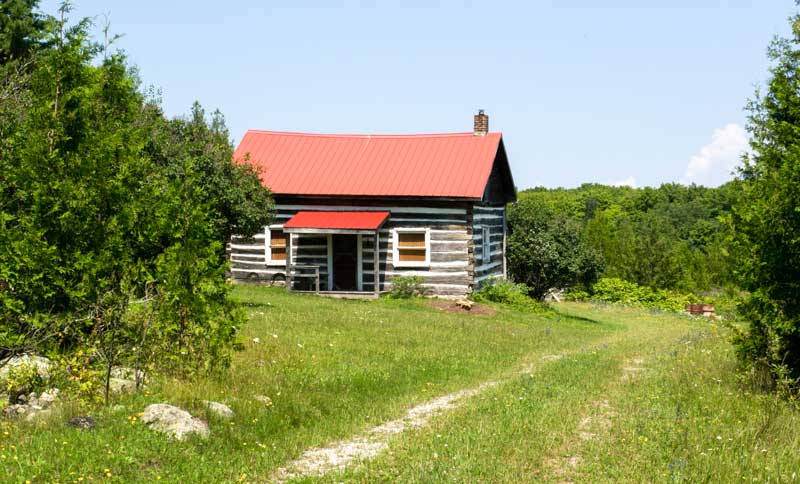MELDRUM BAY—Meldrum Bay is an hour west of Gore Bay and a world away, a tiny waterside hamlet at the end of the road (Highway 540 ends here reads the last road sign) where visitors may sample the latest exciting lifestyle trend at their leisure: slow living. With the map of the Manitoulin Island Cycling Advocates (MICA), touring on bicycles is also idyllic in this tranquil township (www.manitoulincycling.com/maps.html).
As the road rounds a last curve then glides downward toward the pretty marina and stone breakwall nestled in Macrae Cove, the white-painted boats and sun-lit buildings in the village sparkle against the huge sky and waterscapes of deep Manitoulin blue in an exquisite maritime setting.
This is the stretch where, in the 1880s, three sawmills operated at full-tilt and hotels and boarding houses held the hundreds of employees of the thriving industry. On the left below the hill the Meldrum Bay Inn, built during the boom in 1906 as the Grand Manitoulin Hotel, retains the same country charm of those days, meticulously maintained by hosts Shirin and Bob Grover. The wide front staircase climbs to spacious verandahs and an elegant interior full of antiques and period décor; guests still fill the rooms and the restaurant (dinner only) is the only one for miles and miles, considered well worth a special trip, www.meldrumbayinn.com

When Liz Durham and her husband Fred lost the harvest of their 200-acre Michigan fruit farm in 1975, recalls Liz in the kitchen of the charming red-roofed cottage she and Fred later bought, the avid sailors took their boat “up the upper peninsula of Michigan and discovered Meldrum Bay. There was a church supper when we landed, with homemade pie. That did it for my husband,” laughs Liz, a native of Ottawa who met the American veteran of the Korean War at the Université de Montreal. “We both liked remote places that are off the beaten path and Meldrum Bay seemed like a time capsule from mid-century.” Fred Durham passed away 10 years ago, and today Liz remains a community stalwart who still loves “the caring concern of the community, the rural way of life, the way people pitch in and make things happen together. For example,” says Liz, “the harbour is maintained by the villagers who also put in the docks in the spring and take them out in the fall.” Community members—“around 50 stubborn people”—hold dinners and bake sales to raise money for projects they want to realize.
We head out of town climbing west up the escarpment, past the United Church (1920) and the Community Hall (1932), along roads that define Manitoulin at its most rural. Tall elms and maples and old rail fences line Mississagi Lighthouse Road and broad fields demarcate the still-active beef farms and lands abandoned long ago. We arrive at Wickett Lake, declared a bird sanctuary by George Wickett, whose family had arrived here in 1877, where cricket and bird song fill the summer air around the stillness of the small lake. Those interested in birding and kayaking on Wickett Lake should “ask locally,” says Liz, “about how to get here,” as the drive to the lake is through a working farm.
On Cemetery Road North, “a great, glorious drive in fall,” the cemetery’s old stones tell many stories of the early settlers; the road leads to the intersection of Maggie’s Road, named after Maggie Doyle who lived in the minuscule log cabin as a mother and widow whose grandchildren now keep it in pristine condition, still without electricity or running water.
At the end of this road, we come upon the dazzling Mississagi Strait Lighthouse perched at Manitoulin’s farthest western edge in a dramatic landscape of high limestone cliffs and crashing waves below. Mississagi Strait (and its magnetic shoals) is home to perhaps the most spectacular tales of shipwrecks, including rumours of the French ‘Griffon’ in 1679, and of whisky smugglers, hardships of the weather and the rugged, lonely life of the keepers at the western treacherous tip of the Island. The clapboard lighthouse was built in 1873 and is “an outstanding example of the Georgian Bay style” of lighthouses, with living quarters on a second floor and the light on the top, lit by coal oil fires.
The 1873 lantern house from the top of the lighthouse sits in Liz Durham’s yard, “the one in the well-known vintage photograph of the gathering at the lighthouse to celebrate Queen Victoria’s Diamond Jubilee,” she says. “My gazebo is the original wooden top that was replaced by steel in the 1920s, during Ab Grant’s tenure as lighthouse keeper. Instead of burning the discarded lantern house, Mr. Grant and his two older boys brought it by boat around to his home in Meldrum Bay and set it up as a playhouse for his younger children.”
The Fog Horn Station building now houses a lounge and kitchen for visitors and campers who stay at the available sites ($25/night plus $10 for electricity), enjoying a spectacular dark sky canopy of brilliant stars; there are hiking trails and swimming coves nearby. The manager this summer is Maddy Wagar, who can be reached at mississagilighthousecamping@gmail.com and via Facebook.
Back in the village, the Net Shed Museum unveils the history and artifacts of the booming commercial fishing industry that started up in about 1897, and early farm and domestic implements. Joe Millman started his fishing business here to sew, repair and dry his nets, the last such net shed remaining in the bay. During the fishing boom, twenty-five tons of fish were caught and shipped weekly from this and other fishing ports in the North Channel; on a windless day, it’s possible to see the submerged long pier that served as a dock for Millman’s steam tugs. The absorbing Museum, begun as a Centennial project, is celebrating its 50th year and is open Tuesday to Sunday from 12 to 4 pm and from 7 to 9 pm in July and August.
Across the street is the imposing Millman house, now owned by another local family and home to Dove’s Place, a separate wooden shanty that displays the distinctive clothing, accessories and jewellery designs of Dawn Marie Wickett. She also sells a range of “thriftware”—useful pre-loved items. Open seven days a week in summer from 11 am to 4 pm and 7 to 9 pm. Find them on Facebook.
The Olde General Store (circa 1900) beside the Inn was bought in 2016 by Dawn and Dave Vien from the Niagara region—Dave is the great-grandson of Maggie Doyle and spent summers here from the age of six months until he was 14—to serve the communities of Meldrum Bay and Cockburn Island with groceries and other staples (like ice cream!) Their adjacent outdoor snack bar of good burgers, dogs and fries is doing a brisk business as the only lunchtime option in town; glass-bottom kayak, canoe and paddleboard rentals are also available here. The Store is open seven days a week until Labour Day and is on Facebook.
At bayside across from the store, Breakwater Park accommodates tent and trailer camping—check at the cedar-shingled Customs building for rates; this modern, relaxing base for international boaters and other visitors has a verandah for viewing the marine scene, picnic tables, a lounge with maps, washrooms and showers.
The road to Meldrum Bay promotes a leisurely appreciation of the communities of the west end of the Island, all worthy of a closer look: Evansville, Elizabeth Bay, Misery Bay Provincial Park, Silver Water, the Purvis fishery at Burnt Island, and Silver Lake. The powwows of Sheshegwaning First Nation (mid-June) and Zhiibaasing First Nation (August 26-27, 2017) welcome visitors in lovely, intimate settings.
“Bring your inner resources,” advises Liz Durham, “and your curiosity. If you don’t expect to be entertained, there’s lots to do!”
More detailed information about Meldrum Bay and environs may be found in Shelley J. Pearen’s ‘Exploring Manitoulin,’ available at the Expositor Bookstore. ‘Meldrum Bay…the way it was,’ based on stories by Archie Wickett, is available at the Net Shed Museum.
For events listings in all communities, pick up ‘Manitoulin’s Magazine 2017,’and the weekly Manitoulin West Recorder and The Manitoulin Expositor newspapers for updated news and events.





